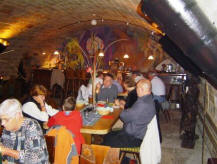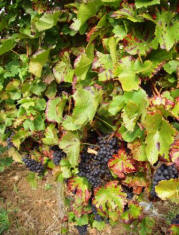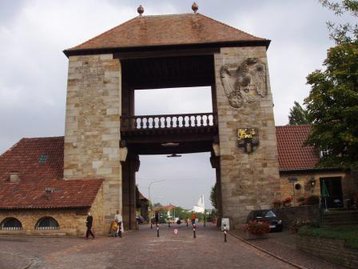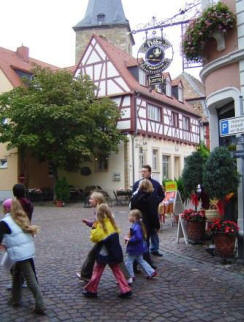
Costa del sol bjuder på många dina utflyktsmål.
Läs om mina förslag på vackra bergsturer.
Välkommen till min webbsida som handlar om trivsamma platser i Europa, utflykter i Andalusien och sköna promenader i Stockholm.
Klicka på det som intresserar dig!
Trevlig läsning
DEUTSCHE WEINSTRASSE – Germany’s oldest wine trail
E451 (north: exit 25; E50 exit 21; south: exit 51 from E35, A5) / ? /
The staking out and signposting of a tourist-cum-wine trail was began as early as 1936 in the shelter of the mountain range Pfalzer Wald. Here vineyards stretch out for miles on end between the wooded mountains and the fertile Rhine valley. Picturesque little towns and villages are lined up like beads on a rosary along the meandering road and cosy wine houses woo you to come in and sample their wares.
The art of wine making was introduced by the Romans, who encountered a climate here very similar to that of the Mediterranean countries. This part of the Rhine valley is more or less surrounded by wooded mountains which give shelter from the cold north-westerly winds. The district is in fact one of the warmest in Germany. Moreover, the soil presents a veritable patchwork of different types of earth, the result of dislocation and faults in the earth’s crust. The different soil types make for ideal winemaking conditions, creating the variety necessary to produce many different wine tastes. Hence, in Pfalz you can sample wines of varying characters ranging from dry, robust red wines to white wines such as Burgundy or Riesling and of course Sekt, as well as a range of sweet dessert wines. Not only wine is grown here, by the way. In this mild climate figs, almonds, apricots, peaches, chestnuts and lemons also thrive. If you arrive in the springtime you will be met by a cascade of fruit trees in full bloom. If you wait until autumn you will be rewarded by
the golden colour display of the vine leaves!
IN THE WINE FARMER’S BACK YARD
A typical feature of most villages or towns along the wine trail is the one long main street with just a few side streets leading off it. In the centre we have the church and town hall. Beautiful half-timbered or reddish brown sandstone houses with colourful shutters throng the streets. Each house has a gigantic door leading into a courtyard. Today many of these courtyards have been turned into pleasant outdoor restaurants offering wine tasting, but in others frantic work is still going on at wine harvest time. Push the door ajar and you can witness the farmer harvesting the grapes. The actual picking of the grapes is done by a great big, rented wine harvester. Subsequently the grapes are poured into a trailer of stainless steel which the farmer then drives home, after securing it behind his tractor. In the courtyard the grapes are crushed, using a colossal “screw” at the bottom of the trailer and the whole glorious mess is swiftly transferred through a hose into a container. It has to be a speedy procedure because the wine workers are paid per hour. Behind the farmers’ courtyards, and between the villages, enormous vineyards spread out as far as the eye can see, growing all varieties of grape, blue, red and green.

OFF THE BEATEN TRACK
Up in the mountains sit fortresses and castles, all with their own story to tell of times gone by. Keep a look-out for tumble-down walls, ruins and towers and do make a detour or two up into the mountains! There are some lovely forest walks up here. Lots of rambling paths are especially marked out, but you can also go for walks down among the vineyards, following so-called Lehrpfade, or Educational Paths, where you get to learn about wine from signposts along the way. On either side of the road are many lovely towns or villages which have been spared the annoying car traffic of the busy thoroughfare. Why not go exploring a little - you may come upon a “wild strawberry patch” of your very own!
WINE TASTING IN A BARREL
One of those towns off the beaten track is Freinsheim. The medieval town centre is totally surrounded by a wall with gates and towers. In two of the towers it is even possible to rent a little apartment, and in a third tower you get to sample some wine. Wine and good food can also be had in one of the many restaurants in Freinsheim’s beautiful old houses which ooze ambience. The bustling Spa of Bad Dürkheim, or the slightly quieter Deidesheim, tell us we are in a much loved tourist spot, full of nice hotels and inns. In Bad Dürkheim you can eat your dinner in a gigantic wine barrel and Deidesheim has its attractive Gasthof zur Kanne which dates back to the 12th century with a Michelin star to boot. Rathauskeller is another good choice of restaurant, as is Deidesheimer Hof. In the town hall (Rathaus) you can learn even more about wine in the museum situated in this splendid building, and in a nearby park they have planted a large amount of wine of different types, complete with name tags.
FESTIVITIES ALL YEAR ROUND

The wine metropolis of Neustadt is a slightly larger town with blocks of flats and a traffic problem, which at first glance you may wish to pass by. But if you take the trouble to wriggle your way into the Altstadt - and manage to find a parking space - you can then have an interesting wander through the car-free alleyways and admire the wonderful old houses around Marktplatz. In one of these, Haus des Weines, you can sample up to a hundred different Neustadt wines. The oldest house around this square, a Gothic building, has stood the test of time for a good 800 years, while the church is approximately 100 years younger, and all the rest were built during later epochs in Baroque or Renaissance styles. Neustadt is also the town of wine harvest festivals. The end of September-beginning of October is the time to be here, when the Wine Queens of both Germany and Pfalz are elected with much ceremony.
Wurstmarkt, however, arguably the greastest wine festival of them all, takes place in Bad Dürkheim. Wurstmarkt, odd name for a wine festival, you might say. But at this festival copious amounts of sausages, bread and wine are consumed. Half a million Schoppen Wein will be drunk here each year, and a Schoppen is not a small glass. All the other places have their own festivities, so no matter what time of year you happen to find yourself in Pfalz, there is bound to be some festival or other in the
vicinity. Just don’t go by car! For a wine festival outing, take the trusty train. It runs between all the main cities.

SÜDLICHE WEINSTRASSE
South of Neustadt, the southern leg of the wine trail takes over, and it is probably the nicer of the two. Here the mountains creep up very close, framing the beautiful landscape in quite a spectacular fashion. High up on a mountain top sits Hambacher Schloss, the cradle of German democracy. This is where the German flag was first hoisted, and an exhibition relates the course of events, as, in 1830, 30,000 enthusiasts rallied here, demanding freedom, a German unification and a European federation. The 1000-year old castle looks down on the vineyards, and we can rest our feet in the outdoor restaurant with a view across to France. On a clear day you can actually make out the church steeple at Strasbourg. Vineyard after glorious vineyard trails away into the distance all the way up to the French border.

HILL AND DALE
But we really have to make a little detour or two at this point. St Martin is a stone’s throw from the wine trail, a gem of a town and well worth a visit. To get to Annweiler, which sits in a pretty valley below the 1000-year old castle Trifels, we have to make a slightly longer detour up into the mountains. I also recommend a stroll down the lanes around Marktplatz and along the little brook Queich with its great water wheels. Everywhere half-timbered houses continue to fascinate, the worthy setting for wine-houses, restaurants and hotels. There is also a restaurant up at Trifels with a ramblers’ path leading all the way up. The view is fantastic and shows a different side to the Pfalz landscape. Here, the mountains are the main feature, something which is obvious on our way back after our detour.
A few more friendly wine villages line up along the wine trail before we get to the French border. One of these is sweet little Dörrenbach with its exciting defence church, complete with four towers, another is big Bad Bergzabern. I say big, because, as in Neustadt, you have to go in search for a parking place before you can relax in the Spa park or stroll down the pedestrian streets in the old town. Bad Bergzabern has a magnificent 16th century castle, an attractive group of half-timbered houses around Marktplatz and of course the famous restaurant Zum Engel, housed in an impressive Renaissance building from the 17th century.
We are at journey’s end when we reach Das Deutsche Weintor in Schweigen, which marks the finishing line of Germany’s oldest “Ferienstrasse”. But this does not mean the end of the wine trail. Over on the French side of the border it just changes name, calling itself Route du Vin. The Germans, however, pretend not to know about this, just as the French refuse to accept the existence of a wine trail north of Weintor.
Das Deutsche Weintor